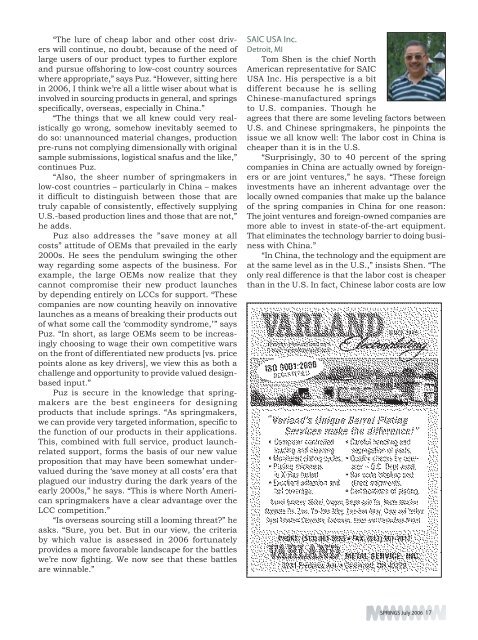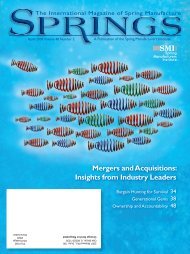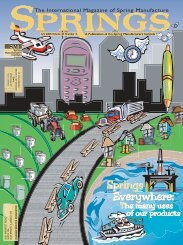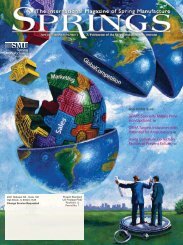Solid Height - Spring Manufacturers Institute
Solid Height - Spring Manufacturers Institute
Solid Height - Spring Manufacturers Institute
Create successful ePaper yourself
Turn your PDF publications into a flip-book with our unique Google optimized e-Paper software.
“The lure of cheap labor and other cost drivers<br />
will continue, no doubt, because of the need of<br />
large users of our product types to further explore<br />
and pursue offshoring to low-cost country sources<br />
where appropriate,” says Puz. “However, sitting here<br />
in 2006, I think we’re all a little wiser about what is<br />
involved in sourcing products in general, and springs<br />
specifically, overseas, especially in China.”<br />
“The things that we all knew could very realistically<br />
go wrong, somehow inevitably seemed to<br />
do so: unannounced material changes, production<br />
pre-runs not complying dimensionally with original<br />
sample submissions, logistical snafus and the like,”<br />
continues Puz.<br />
“Also, the sheer number of springmakers in<br />
low-cost countries – particularly in China – makes<br />
it difficult to distinguish between those that are<br />
truly capable of consistently, effectively supplying<br />
U.S.-based production lines and those that are not,”<br />
he adds.<br />
Puz also addresses the ”save money at all<br />
costs” attitude of OEMs that prevailed in the early<br />
2000s. He sees the pendulum swinging the other<br />
way regarding some aspects of the business. For<br />
example, the large OEMs now realize that they<br />
cannot compromise their new product launches<br />
by depending entirely on LCCs for support. “These<br />
companies are now counting heavily on innovative<br />
launches as a means of breaking their products out<br />
of what some call the ‘commodity syndrome,’ ” says<br />
Puz. “In short, as large OEMs seem to be increasingly<br />
choosing to wage their own competitive wars<br />
on the front of differentiated new products [vs. price<br />
points alone as key drivers], we view this as both a<br />
challenge and opportunity to provide valued designbased<br />
input.”<br />
Puz is secure in the knowledge that springmakers<br />
are the best engineers for designing<br />
products that include springs. “As springmakers,<br />
we can provide very targeted information, specific to<br />
the function of our products in their applications.<br />
This, combined with full service, product launchrelated<br />
support, forms the basis of our new value<br />
proposition that may have been somewhat undervalued<br />
during the ‘save money at all costs’ era that<br />
plagued our industry during the dark years of the<br />
early 2000s,” he says. “This is where North American<br />
springmakers have a clear advantage over the<br />
LCC competition.”<br />
“Is overseas sourcing still a looming threat?” he<br />
asks. “Sure, you bet. But in our view, the criteria<br />
by which value is assessed in 2006 fortunately<br />
provides a more favorable landscape for the battles<br />
we’re now fighting. We now see that these battles<br />
are winnable.”<br />
SAIC USA Inc.<br />
Detroit, MI<br />
Tom Shen is the chief North<br />
American representative for SAIC<br />
USA Inc. His perspective is a bit<br />
different because he is selling<br />
Chinese-manufactured springs<br />
to U.S. companies. Though he<br />
agrees that there are some leveling factors between<br />
U.S. and Chinese springmakers, he pinpoints the<br />
issue we all know well: The labor cost in China is<br />
cheaper than it is in the U.S.<br />
“Surprisingly, 30 to 40 percent of the spring<br />
companies in China are actually owned by foreigners<br />
or are joint ventures,” he says. “These foreign<br />
investments have an inherent advantage over the<br />
locally owned companies that make up the balance<br />
of the spring companies in China for one reason:<br />
The joint ventures and foreign-owned companies are<br />
more able to invest in state-of-the-art equipment.<br />
That eliminates the technology barrier to doing business<br />
with China.”<br />
“In China, the technology and the equipment are<br />
at the same level as in the U.S.,” insists Shen. “The<br />
only real difference is that the labor cost is cheaper<br />
than in the U.S. In fact, Chinese labor costs are low<br />
SPRINGS July 2006 17





